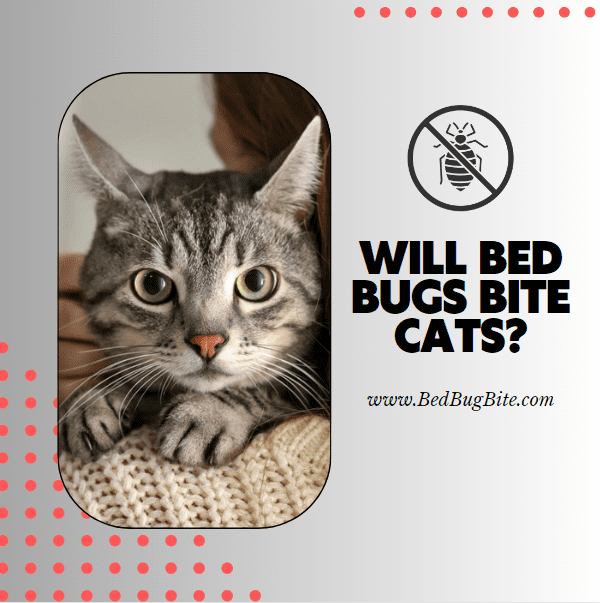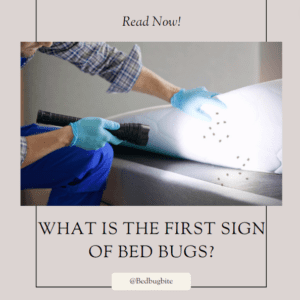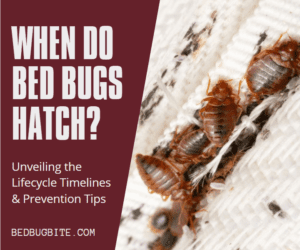Introduction
Welcome to our comprehensive guide on a question that concerns many pet owners: Will bed bugs bite cats? When we think of bed bugs, our first concern is often the discomfort and annoyance they cause to humans. However, as our feline friends share our homes, it’s crucial to understand how these pests might affect them. Bed bugs, known scientifically as Cimex lectularius, are small, elusive insects that thrive in the cozy corners of our bedrooms and living spaces. They are expert hitchhikers, finding their way into our homes on luggage, furniture, and other items. Their goal? To feed on warm-blooded hosts, primarily humans. But this raises an important question for every cat owner: are our pets at risk too?
Click Here to Read More About Bed Bugs!
Understanding the behavior of bed bugs is the first step in protecting our homes and the animals we love. These pests prefer human hosts but will resort to feeding on pets, including cats, if necessary. This guide dives deep into the nature of bed bugs, their preferences, and how they interact with cats. We’ll explore whether your furry companion is at risk, how to spot signs of bed bug bites on cats, and the steps you can take to protect your pets and your home from these unwelcome invaders.
The importance of this issue cannot be overstated. A well-informed pet owner is the first line of defense against bed bugs. By recognizing the signs of an infestation and understanding how to respond, you can keep your home safe and comfortable for every member of your family—two-legged and four-legged alike.
For further reading on bed bugs and their behavior, the Environmental Protection Agency (EPA) provides a wealth of information on identifying and dealing with bed bug infestations (EPA Bed Bugs Information). This resource offers valuable insights into the world of bed bugs, equipping you with the knowledge you need to tackle this challenge head-on.
Understanding Bed Bugs
Diving into the world of bed bugs provides us with insights necessary for combating these pests effectively. Bed bugs, or Cimex lectularius, are nocturnal insects known for their stealthy behavior and preference for human blood. With a reddish-brown color and a flat, oval shape, these pests are experts at hiding in crevices and cracks close to their feeding grounds—our beds. Understanding their life cycle is crucial; it begins with an egg, progresses through several nymph stages, and culminates in adulthood, with females laying hundreds of eggs in their lifetime. This cycle, coupled with their elusive nature, makes controlling and eliminating bed bugs a challenging task.
Common Signs of a Bed Bug Infestation in Homes
Identifying a bed bug infestation early is vital to preventing a larger problem. Key signs include:
- Tiny blood stains on sheets or pillowcases, a result of their feeding.
- Dark or rusty spots of bed bug excrement on mattresses, bedding, and walls.
- Egg shells or shed skins in areas where bed bugs hide.
- An unpleasant, musty scent from the bugs’ scent glands.
Being vigilant for these indicators can help you catch an infestation before it escalates.
How Bed Bugs Find Their Hosts

Bed bugs are attracted to warmth, carbon dioxide, and certain chemicals emitted by humans and animals as they sleep. This combination acts as a beacon, guiding bed bugs to their next meal. Despite their preference for human hosts, they will bite pets if no other food source is available. Their flat bodies allow them to hide easily in small spaces during the day, emerging at night to feed.
What Attracts Bed Bugs?
Contrary to popular belief, bed bugs are not drawn to dirt or decay but to the presence of hosts from whom they can feed. High carbon dioxide levels and warmth are their main attractions, making sleeping humans or pets perfect targets. Understanding these attractions is key in preventing bed bugs from making your home theirs.
Armed with knowledge about bed bugs, their behaviors, and what attracts them, homeowners and pet owners can take proactive steps to prevent infestations. Awareness and early detection play critical roles in keeping these pests at bay, ensuring the safety and comfort of all home inhabitants. For more detailed information on bed bug habits and their life cycle, the Centers for Disease Control and Prevention (CDC) offers an extensive overview that can further your understanding and aid in prevention efforts (CDC Bed Bugs Overview). This knowledge is not just power—it’s the foundation of effective bed bug management and prevention strategies.
The Reality of Bed Bugs and Cats
Exploring the dynamic between bed bugs and our feline companions uncovers a nuanced aspect of pest infestation in homes. While bed bugs exhibit a clear preference for human hosts due to our exhalation of carbon dioxide and the warmth we provide, these opportunistic feeders will not shy away from biting pets, including cats, when human hosts are not accessible. This shift in host preference underlines the adaptability of bed bugs and poses a direct question to pet owners: Is your cat at risk?
Do Bed Bugs Bite Cats?
Indeed, bed bugs can and will bite cats if the conditions push them towards alternative food sources. Cats, with their warm bodies and regular sleeping habits, can attract bed bugs. However, the extent of this issue may vary based on the severity of the infestation and the availability of human hosts.
Conditions Under Which Bed Bugs May Target Pets
Bed bugs’ transition to biting pets often occurs in heavily infested environments where competition for food is high, or in situations where human hosts are not readily available, such as during the day when people are away from home but pets remain in the infested areas.
Comparing Bed Bug Bites on Humans vs. Pets
While bed bug bites on humans are typically found on exposed areas of skin such as the arms, neck, and face, identifying these bites on cats can be more challenging due to their fur. Bed bug bites on cats might manifest through unusual scratching, biting, or licking behaviors, driven by the irritation of the bites.
Understanding that bed bugs can indeed bite cats shifts the focus towards early detection and effective management of bed bug infestations to protect all household members. This insight not only broadens our perspective on bed bug behavior but also emphasizes the need for comprehensive pest control strategies that consider the well-being of pets.
By recognizing the potential for bed bugs to bite pets, homeowners can take proactive measures to inspect and monitor their pets for signs of bites, alongside implementing regular pest management practices. Such diligence ensures a healthier, safer environment for both pets and their owners. For further guidance on protecting your pets from bed bugs and other pests, the American Veterinary Medical Association (AVMA) provides resources and advice to keep your furry family members safe and healthy (AVMA Resources on Pet Health). Engaging with these resources can empower pet owners with the knowledge needed to safeguard their pets against the discomfort and health risks associated with bed bug bites.
How to Identify Bed Bug Bites on Cats
Identifying bed bug bites on cats is crucial for ensuring the well-being of our feline friends and effectively managing pest infestations in our homes. While bed bugs do not exclusively target pets, cats can become victims in the presence of an infestation. The challenge lies in recognizing these bites amidst the natural fur coat and typical behaviors of cats. Understanding the signs and symptoms of bed bug bites on cats is the first step in addressing the issue and providing the necessary care.
Describing What Bed Bug Bites Look Like on Cats
Bed bug bites on cats may appear as small, red, and sometimes swollen spots on the skin. These bites are often hard to see under the cat’s fur but may be detected by the cat’s response to the irritation, such as excessive scratching, grooming, or a visible agitation. Unlike flea bites, which are primarily around the neck and base of the tail, bed bug bites can occur anywhere on the body.
Distinguishing Bed Bug Bites from Other Insect Bites or Skin Conditions
To correctly identify bed bug bites on your cat, consider the following:
- The pattern of the bites: Bed bug bites often occur in a linear or clustered pattern.
- The absence of a red spot in the center, which is common in flea bites.
- Observing any concurrent signs of bed bugs in your living environment, such as small blood stains or excrement spots on bedding.
Understanding these distinctions is crucial for accurate identification and appropriate response.
The Importance of Veterinary Consultation
If you suspect your cat has been bitten by bed bugs, consulting a veterinarian is vital. A professional can offer a definitive diagnosis and recommend treatment options to alleviate your cat’s discomfort. Moreover, a vet can help differentiate bed bug bites from other conditions that might exhibit similar symptoms, ensuring your cat receives the care it needs.
Identifying and treating bed bug bites on cats promptly is essential for their comfort and health, and it plays a significant role in controlling the spread of infestations in your home. By paying close attention to your pet’s behavior and physical condition, and seeking professional advice when needed, you can protect your beloved pets from the nuisance and potential harm of bed bug bites. For pet owners seeking more information on how to maintain their pets’ health and manage pest issues, the American Society for the Prevention of Cruelty to Animals (ASPCA) offers valuable resources and guidance (ASPCA Pet Care). Accessing these resources can equip pet owners with the knowledge and tools needed to ensure their cats remain healthy and happy, even in the face of pest challenges.
Preventing Bed Bug Infestations in Pet-Friendly Homes
Preventing bed bug infestations in pet-friendly homes is essential not only for the comfort and safety of human inhabitants but also for our pets, who can suffer from bed bug bites just as we do. Understanding how to create an environment that is less inviting to bed bugs can significantly reduce the risk of an infestation. This section provides actionable strategies for homeowners to protect both their homes and their pets from these unwelcome pests.
Strategies to Prevent Bed Bugs from Entering Your Home
Preventing an infestation begins with vigilance and the right preventive measures:
- Regular Inspection: Check second-hand furniture, bedding, and luggage for signs of bed bugs before bringing them into your home.
- Reduce Clutter: Minimize hiding spots for bed bugs by keeping your home tidy and clutter-free.
- Use Protective Covers: Encase mattresses and box springs in bed bug-proof covers to deter infestations.
Adopting these strategies can significantly lower the risk of bed bugs finding a home in your space.
Maintaining a Clean and Clutter-Free Environment
A clean home is not just about aesthetics; it’s a critical step in pest prevention:
- Vacuum Regularly: Regular vacuuming can remove bed bugs and their eggs from carpets, floors, and furniture.
- Wash Bedding Frequently: Wash and dry bedding at high temperatures to kill any bed bugs or eggs present.
- Inspect Pet Areas: Regularly check areas where your pets sleep and play for signs of bed bugs.
Implementing these cleaning habits can make your home less attractive to bed bugs.
Recommendations for Regular Pet Bedding Cleaning and Inspection
Pets’ bedding and resting areas can be hot spots for bed bugs:
- Wash Pet Bedding: Regularly launder your pet’s bedding in hot water and dry it on a high heat setting to kill bed bugs.
- Inspect After Visits: Check your pet and their bedding after visits to groomers, kennels, or other pets’ homes for any signs of bed bugs.
- Pet-Safe Pest Control: Consider using pet-safe pest control measures in areas where your pets sleep and spend most of their time.
By focusing on prevention and maintaining a vigilant cleaning routine, pet owners can create a safer, more comfortable environment for their pets and themselves. These steps not only help in preventing bed bug infestations but also promote a healthier living space for everyone in the household. For more comprehensive guidance on preventing bed bugs in homes with pets, the National Pest Management Association (NPMA) offers resources and tips tailored to pet owners (NPMA’s Guide to Bed Bugs and Pets). Engaging with these expert resources can provide additional strategies and peace of mind for those looking to protect their homes and furry family members from the threat of bed bugs.
Treating Bed Bug Bites on Cats
Treating bed bug bites on cats is a crucial step in ensuring the comfort and health of your feline companion, as well as in managing and preventing further bed bug infestations within your home. Recognizing the signs and taking immediate action can alleviate your pet’s discomfort and prevent complications. Here, we outline safe and effective methods to treat bed bug bites on cats, highlighting the importance of professional veterinary care and offering home remedies for relief.
Safe and Effective Methods to Treat Bed Bug Bites on Cats
Immediate and appropriate care is essential for treating bed bug bites on cats:
- Consult a Veterinarian: A professional can confirm the cause of the bites and prescribe medication to relieve itching and prevent infection.
- Anti-itch Creams and Medications: Use pet-safe anti-itch creams or antihistamines recommended by your vet to soothe the irritation.
When to See a Veterinarian for Bed Bug Bites on Pets
Certain signs indicate the need for professional medical attention:
- Severe Scratching or Biting: This can lead to skin infections and more serious complications.
- Allergic Reactions: Some pets may exhibit allergic reactions to bed bug bites, requiring immediate veterinary care.
Home Remedies and Preventive Measures to Soothe Your Cat’s Skin
While professional advice is paramount, some home remedies can offer temporary relief:
- Aloe Vera: Apply pure aloe vera gel to soothe the skin and reduce itching. Ensure it is free from additives that may be harmful to cats.
- Oatmeal Baths: A gentle oatmeal bath can provide relief for irritated skin. Make sure to use cat-safe products and to rinse thoroughly.
Addressing bed bug bites on cats promptly and effectively is key to ensuring their well-being and preventing the spread of infestations. In addition to treatment, ongoing prevention efforts and maintaining a clean environment are critical in protecting your pets and your home from bed bugs. For comprehensive advice on pet health and the management of pest-related issues, the American Pet Products Association (APPA) provides resources and information to help pet owners navigate these challenges (APPA Resources). Utilizing these expert insights can empower pet owners to take proactive steps in caring for their pets’ health and in maintaining a pest-free home.
Professional Bed Bug Extermination and Pet Safety
The role of professional pest control in managing bed bug infestations cannot be overstated, especially when it comes to ensuring the safety and comfort of all household members, including pets. Engaging with professional exterminators offers a comprehensive approach to eradicating bed bugs, but it also raises concerns about pet safety during treatment processes. In this section, we delve into the importance of professional pest control for bed bug extermination and outline key considerations for keeping your pets safe during and after treatment.
The Role of Professional Pest Control in Bed Bug Extermination
Professional pest control services bring expertise and specialized methods to the battle against bed bugs, significantly increasing the chances of completely eradicating the pests from your home. These experts utilize a combination of chemical and non-chemical treatments tailored to your specific situation, ensuring effective elimination while minimizing risk to human and pet residents.
Ensuring Your Cat’s Safety During Professional Bed Bug Treatment
To safeguard your pets during pest control treatments, consider the following measures:
- Relocate Pets During Treatment: Arrange for your pets to stay with a friend, family member, or at a pet boarding facility during the extermination process.
- Discuss Pet Safety with the Exterminator: Prior to treatment, inform the pest control professional about any pets in your home and discuss safety measures to protect them.
- Follow Post-Treatment Instructions: Adhere strictly to the pest control professional’s guidance regarding when it is safe for pets to return to the treated areas.
Questions to Ask Your Pest Control Professional About Pet Safety
It’s crucial to communicate openly with your pest control provider regarding pet safety. Key questions include:
- What chemicals will be used, and are they safe for pets?
- What precautions should be taken to protect pets during and after treatment?
- How long should pets stay away from the treated areas?
By taking an active role in the extermination process and prioritizing pet safety, homeowners can ensure a smooth and effective bed bug eradication effort. Professional pest control services, when properly coordinated with pet safety in mind, offer a powerful solution to bed bug infestations, restoring peace and comfort to your home. For additional information on selecting a pest control service and ensuring the safety of pets during treatments, the National Association of Pest Management Professionals (NAPMP) provides resources and guidelines to help homeowners make informed decisions (NAPMP’s Guide to Choosing a Pest Professional). Leveraging these resources can help you navigate the process of professional bed bug extermination with your pets’ well-being as a priority, ensuring a pest-free and safe home environment for all.
Conclusion
As we conclude our exploration into whether bed bugs bite cats, it’s clear that these pests can indeed pose a risk to our feline friends, albeit less frequently than to humans. This journey through the habits of bed bugs, their interaction with pets, and the strategies to protect our homes and loved ones from infestations underlines the importance of vigilance, early detection, and proactive management. By understanding bed bugs’ behavior, recognizing the signs of their presence, and taking decisive action to prevent and treat infestations, pet owners can ensure the safety and comfort of all household members—both human and animal.
Recap of Key Insights
- Bed bugs prefer human hosts but will not hesitate to bite pets, including cats, in certain conditions.
- Recognizing and treating bed bug bites on pets promptly can prevent discomfort and more serious health issues.
- Preventative measures, such as maintaining a clean and clutter-free home, are critical in deterring bed bug infestations.
- Professional pest control services play a vital role in effectively managing bed bug challenges, with particular attention to pet safety.
Taking Proactive Steps
The responsibility of pet owners extends beyond regular care to include protecting pets from potential threats like bed bugs. By implementing the strategies discussed, including regular inspections, cleanliness, and engaging professional help when needed, you can create a safer environment for your pets and family.
Further Resources
For those seeking more information on managing bed bugs and ensuring the health and safety of pets, additional resources include:
- Centers for Disease Control and Prevention (CDC): Provides comprehensive guides on bed bugs and health-related information.
- Environmental Protection Agency (EPA): Offers tips on bed bug prevention, identification, and eradication methods.
In closing, the battle against bed bugs is a continuous one, requiring awareness, preparation, and action. As pet owners and caretakers of our homes, it’s our duty to employ the knowledge and tools at our disposal to protect those we love from the nuisance and potential harm of bed bugs. Armed with this guide, you are now better equipped to ensure your home remains a safe haven for all its inhabitants, free from the threats posed by bed bugs.




